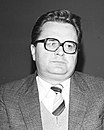
Back Eleccions parlamentàries poloneses de 1985 Catalan Elecciones legislativas de Polonia de 1985 Spanish Élections législatives polonaises de 1985 French Poolse parlementsverkiezingen 1985 Dutch Wybory parlamentarne w Polsce w 1985 roku Polish Парламентские выборы в Польше (1985) Russian
| |||||||||||||||||||||||||||||
All 460 seats in the Sejm 231 seats needed for a majority | |||||||||||||||||||||||||||||
|---|---|---|---|---|---|---|---|---|---|---|---|---|---|---|---|---|---|---|---|---|---|---|---|---|---|---|---|---|---|
| |||||||||||||||||||||||||||||
Parliamentary elections were held in Poland on 13 October 1985.[1] According to the Constitution of 1952 the elections should have been held every 4 years, that is in the spring of 1984, but since the internal political situation was still considered "unstable" even after the repealing in 1983 of the Martial Law, the Sejm voted to extend its own term at first indefinitely (on February 13, 1984) and then until August 31, 1985 (on December 3, 1984), fixing the elections to be held not beyond the end of 1985. As was the case in previous elections, only candidates approved by the Communist regime (coalesced under the Patriotic Movement for National Rebirth, replacing the similar Front of National Unity) were permitted on the ballot. The outcome was thus not in doubt, nevertheless the regime was hoping for a high turnout, which it could then claim as evidence of strong support for the government among the population. The opposition from the Solidarity movement called for a boycott of the elections. According to official figures 78.9% of the electorate turned out to vote.[2] This turnout, while relatively high, was much lower than the nearly 100% turnout which was reported in previous elections.
It was the last election in Communist Poland in which no real opposition candidates were allowed to participate. The following election in 1989, in which opposition parties could put up candidates for a portion of the seats, resulted in a convincing opposition victory followed by the downfall of the Communist system.
- ^ Dieter Nohlen & Philip Stöver (2010) Elections in Europe: A data handbook, p1491 ISBN 978-3-8329-5609-7
- ^ Nohlen & Stöver, p1503


